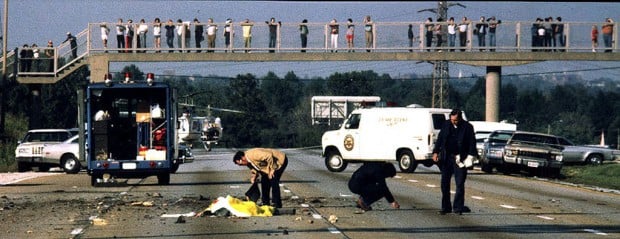A Look Back: St. Louis mobster's quiet death at home unleashes war
Police investigate the scene of Jimmy Michael's murder by car bombing on Sept. 17, 1980. He had lunch downtown and was driving south on Interstate 55 to his home in Mehlville when a bomb shattered his Chrysler Cordoba just short of the Reavis Barracks Road exit. Michaels was 75 when he was killed. Paul Leisure's gang had set the bomb and detonated it by remote control from a van they used to follow Michael's car.
Home from federal prison, Anthony Giordano was hard to find at his old haunts around town. The man known and feared as "Tony G" didn't look so good.
"Aw, hell, I came down with that ... cancer," the profane mobster told a reporter outside the federal courthouse downtown in 1978. "I'm taking the cure, but I don't know how it's going to turn out."
Giordano had been in the crime business since the 1930s, when police dismissed him as a "cheap street hood with patches on his pants." Rising through local organized-crime ranks, he could afford flashy suits and hats. After becoming mob boss in the 1960s, he toned down his wardrobe, lest he draw more attention from FBI snoops.
Giordano's legitimate businesses were the Metropolitan Towing Co., where he was alleged to have threatened a priest with a shotgun, and the Banana Distributing Co. on the city's Produce Row. His rap sheet included convictions for income-tax evasion and conspiring to hide casino ownership in Las Vegas.
Unlike so many others in his trade, Giordano, 67, died peacefully on Aug. 29, 1980, in his modest home at 5966 Finkman Street, south of Francis Park. He had suffered from lung cancer for two years. About 200 people attended a brief memorial inside the mausoleum at Calvary Cemetery. No graveside service or funeral Mass was conducted.
Shortly before his death, mob leaders had recruited John J. Vitale, the old consiglieri (counselor), to come out of retirement and smooth the transition. Police investigators took bets on which of Giordano's nephews would take over.
But peaceful transitions are hard to come by in the crime trade. One of Giordano's longtime allies had been James A. Michaels Sr. But mob enforcer Paul J. Leisure, a former Giordano bodyguard, held a grudge against Michaels over the murder of Leisure's older brother in 1964. Leisure believed Michaels let the killers skip town.
The quiet after Giordano's death lasted 19 days. On Sept. 17, 1980, Michaels got into his Chrysler Cordoba after lunch downtown and headed home to Mehlville. A bomb shattered his car on Interstate 55 near the Reavis Barracks Road exit. Leisure began calling himself No. 1.
The bombing set off St. Louis' last big-time gang war. Leisure was critically injured on Aug. 11, 1981, when a bomb destroyed his own car outside his home. Two weeks later, George "Sonny" Faheen Jr, a nephew of Michaels, was blown up in his Volkswagen in a downtown garage.
The bloodshed unnerved some of Leisure's gang members, who provided the FBI with crucial information. During the trials, tapes of federal buggings proved that real mobsters talk like the ones in the movies. Paul Leisure died in a federal prison hospital in 2000.

Home from federal prison, Anthony Giordano was hard to find at his old haunts around town. The man known and feared as "Tony G" didn't look so good.
"Aw, hell, I came down with that ... cancer," the profane mobster told a reporter outside the federal courthouse downtown in 1978. "I'm taking the cure, but I don't know how it's going to turn out."
Giordano had been in the crime business since the 1930s, when police dismissed him as a "cheap street hood with patches on his pants." Rising through local organized-crime ranks, he could afford flashy suits and hats. After becoming mob boss in the 1960s, he toned down his wardrobe, lest he draw more attention from FBI snoops.
Giordano's legitimate businesses were the Metropolitan Towing Co., where he was alleged to have threatened a priest with a shotgun, and the Banana Distributing Co. on the city's Produce Row. His rap sheet included convictions for income-tax evasion and conspiring to hide casino ownership in Las Vegas.
Unlike so many others in his trade, Giordano, 67, died peacefully on Aug. 29, 1980, in his modest home at 5966 Finkman Street, south of Francis Park. He had suffered from lung cancer for two years. About 200 people attended a brief memorial inside the mausoleum at Calvary Cemetery. No graveside service or funeral Mass was conducted.
Shortly before his death, mob leaders had recruited John J. Vitale, the old consiglieri (counselor), to come out of retirement and smooth the transition. Police investigators took bets on which of Giordano's nephews would take over.
But peaceful transitions are hard to come by in the crime trade. One of Giordano's longtime allies had been James A. Michaels Sr. But mob enforcer Paul J. Leisure, a former Giordano bodyguard, held a grudge against Michaels over the murder of Leisure's older brother in 1964. Leisure believed Michaels let the killers skip town.
The quiet after Giordano's death lasted 19 days. On Sept. 17, 1980, Michaels got into his Chrysler Cordoba after lunch downtown and headed home to Mehlville. A bomb shattered his car on Interstate 55 near the Reavis Barracks Road exit. Leisure began calling himself No. 1.
The bombing set off St. Louis' last big-time gang war. Leisure was critically injured on Aug. 11, 1981, when a bomb destroyed his own car outside his home. Two weeks later, George "Sonny" Faheen Jr, a nephew of Michaels, was blown up in his Volkswagen in a downtown garage.
The bloodshed unnerved some of Leisure's gang members, who provided the FBI with crucial information. During the trials, tapes of federal buggings proved that real mobsters talk like the ones in the movies. Paul Leisure died in a federal prison hospital in 2000.









0 comments:
Post a Comment